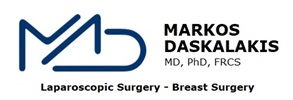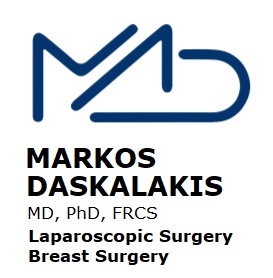Laparoscopic Cholecystectomy
Laparoscopic cholecystectomy is a keyhole operation to remove the gallbladder.

The gallbladder is a small, pear-shaped pouch that sits under the liver in the right upper part of your abdomen. It stores bile that is produced by the liver. When you eat, a non-diseased gallbladder contracts and squirts the bile down the bile duct into the intestine to help with food digestion.
Pain from gallstones is by far the most common indication for a laparoscopic cholecystectomy.
Gallstones
Overview
Gallstones are small stones, usually made of cholesterol, that form in the gallbladder.
Diagnosis
Complications
Complications of gallstones are not uncommon. The most common complications may include:
-
Acute cholecystitis: This is the most common complication of gallstones and represents an acute inflammation of the gallbladder that is often caused by a stone obstructing the gallbladder. This is characterised by a rather constant, and often severe, pain in the right upper abdomen, fever, nausea and vomiting. Current guidelines state that if no contraindications exist patients should be operated on (laparoscopic cholecystectomy) within 7 days of the onset of symptoms. Alternatively patients could be managed with antibiotics, and possibly an ultrasound-guided drainage of the gallbladder, until the inflammation settles down and then arrange a laparoscopic cholecystectomy 6-8 weeks later. Failure to treat acute cholecystitis promptly and adequately could result in sepsis and peritonitis, which are serious and potentially life threatening complications.
-
Obstructive Jaundice: This refers to a yellowish discolouration of the skin and the whites of the eyes. It is often caused by at least one or multiple stones passing from the gallbladder into the main bile duct (common bile duct) and causing obstruction to the flow of bile. Bowel motions often become rather pale and clay-coloured, the urine becomes dark and tea-coloured and the skin becomes itchy. This is often associated with abdominal pain. The presence of a bile duct stone can be confirmed on a scan (called MRCP) but these are occasionally seen on a simple ultrasound scan of the abdomen. The stone might pass spontaneously, but most likely these will need to be removed either by a camera procedure that is passed into the stomach under sedation (called ERCP), or during surgery to explore the bile duct and remove also the gallbladder.
-
Acute pancreatitis: This is acute inflammation of the pancreas gland that sits behind the stomach and produces insulin, to help regulate the levels of our blood sugar, and enzymes to facilitate digestion. The duct of the pancreas joins the main bile duct at the same point into the intestine, just beyond the stomach, and drains its digestive juices into the intestine. A gallstone passing down the bile duct may temporarily block the pancreatic duct resulting in acute pancreatitis; this is more likely to be caused by smaller than larger stones. Acute pancreatitis is an infrequent complication of gallstones and is characterised by a constant central abdominal pain radiating to the back that is often severe and associated with fever, nausea and vomiting. Although it is commonly mild and resolves within few days, acute pancreatitis can be quite severe in 3-out of-10 patients (30%) who then end up with further complications and prolonged hospitalisation.
-
Mucocele of the gallbladder: This is caused usually by a large gallstone that blocks the gallbladder and prevents its content from draining down the bile duct into the intestine. The gallbladder fills up and distends with mucus causing a constant dull ache under the right lower ribcage. Unlike acute cholecystitis, there is no infection here and no symptoms of fever or sepsis.
Treatment
Procedure Indications
- Pain from gallstones is by far the most common indication.
- Bile is made of several substances (cholesterol, bile salts and liver metabolism byproducts) that are sensitive to hormonal changes in the body as well as changes in our weight (weight gain and weight loss). When the balance of these hormonal changes is disturbed, such as what might occur with pregnancies, menstrual cycle, the use of contraceptive pills etc., the balance between these chemicals is disrupted resulting in the precipitation of crystals that clump together forming stones. That’s why women are more likely to develop gallstones than men.
- Gallstones are common, though most gallstones cause no symptoms and are incidentally detected on an ultrasound scan or other form of imaging of the abdomen during the course of investigations for other conditions (and consequently do not require surgery). However, in a proportion of patients the gallstones can cause abdominal pain usually in the right upper abdomen called “biliary colic”. The pain can also be felt in the middle of the chest and sometimes becomes confused with a heart attack. It is not uncommon that some patients end up having extensive heart tests before gallstones are discovered. Most people will describe the pain as of sudden onset, severe, colicky in nature, precipitated by food, especially fatty foods, may be felt like a band gripping across the upper abdomen and may well radiate into the back. It tends to last for few minutes to few hours at a time and often resolves all of a sudden and its own. Attacks of pain of lesser severity are also common. Sometimes the pain might last longer and go on for few days; this is often suggestive of a complication of gallstones such as acute cholecystitis, mucocele of the gallbladder, or pancreatitis. Nausea and vomiting as well as palpitation (the heart beating fast) and sweating are also common symptoms that are associated with the abdominal pain.
- Rarely, polyps might develop in the gallbladder and warrant a cholecystectomy. This is particularly if the polyps are causing symptoms, are multiple, 1cm in size or larger or if they are enlarging. Otherwise, a follow up ultrasound, usually once a year, might be all that is needed to keep an eye on those polyps.
- The gallbladder might rarely become diseased and acutely inflamed (called “cholecystitis”) in the absence of gallstones (called “acalculous cholecystitis”) and require a cholecystectomy.
- Gallbladder cancer in the Western World is quite rare and might require a cholecystectomy as well as liver resection.
Additional Info
The procedure
It is one of the most common operations performed. It involves using a small camera and surgical instruments that are inserted through small cuts (incisions) in your abdomen.
Hospitalisation
Recovery
Complications
After surgery



